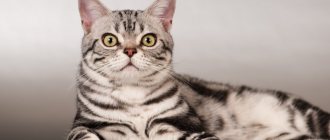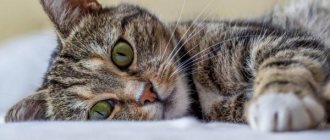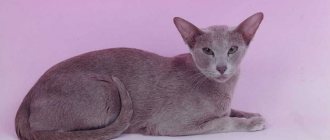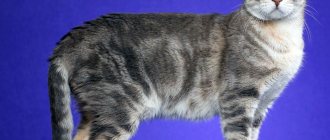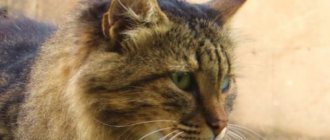Do you want to become the owner of an unusual and rare breed of cats? The American Wirehair is what you are looking for!
The unusualness of this breed lies in the appearance of the coat. It is quite short, disheveled and in appearance looks like links of barbed wire. However, this is only a visual effect. It feels as soft and silky as other cats. Representatives of this breed have an external resemblance to American Shorthairs and are playful and friendly. However, for their wild appearance they received the nickname “punks” of the cat world.
Origin story
American Wirehair cats are close relatives of American Shorthairs.
The first kitten was born to a short-haired cat in the late 60s of the last century in the USA. Its fur was significantly different from its mother’s: it curled into curls, and was so tough that the owner of the animal compared it to wire, marveled at this phenomenon and took the kitten to a familiar breeder, Joan Oshia, “for a show.” During his absence, the remaining kids were killed by a weasel that sneaked into the house. The only kitten was named Adam (symbolic, isn't it?). He grew into a strong and healthy cat, started an affair with a neighbor's mongrel cat and became the father of a large family. All the children were his exact copy.
In 1967, the breeder drew up the first standard and took cats to the first exhibition. The new breed aroused interest among well-known breeders. The breed (with the status “experimental”) began to be actively developed and improved, and this work is still underway.
It is almost impossible to buy an American Wirehair kitten in Russia. All large nurseries are located abroad: in Canada, Germany and the United States of America. The cost of one individual is at least 60 thousand rubles; kittens for exhibitions can cost 100-150 thousand rubles. And don't forget about paying for transportation.
Mr. Cat recommends: Temperament features
The American Wirehair is very popular in its historical homeland due to its remarkable character. These friendly pets are incredibly stress-resistant and quickly adapt to any environment. By the way, read about stress in cats. They are equally comfortable with a silent owner or in the circle of a large and noisy family with small children.
They are playful and active all their lives, even in old age. They will always find something to do and tolerate short-term loneliness calmly.
Very brave hunters and protectors. They confidently make contact even with unfamiliar people and animals. In the event of an attack, they will be able to stand up for themselves perfectly, but they will never be the first to show aggression.
Standards
American Wirehair cats are strong and hardy animals. Females are “ladylike” fragile, and weigh no more than 4-5 kg, while males sometimes gain over 8 kg.
| Standard | Description |
| Torso | It has well-developed muscles, a flat and wide back, a convex chest and a strong, medium-length neck. The height at the withers cannot be greater than the length of the body. |
| Paws | Not long, sinewy, straight and slender. The fingers are round, slightly elongated, strong and elastic. |
| Tail | The length is equal to the distance from the tailbone to the shoulder blades. It is quite thick, smooth, wide at the base, and noticeably narrows towards the tip. |
| Head | Wedge-shaped, the width and length of the muzzle have the same parameters. The chin is square, developed, and clearly stands out. The nose can be of medium length or very short. “Stop” is highlighted on the bridge of the nose. High cheekbones. |
| Eyes | Almost round in shape, large, open. They stretch out barely noticeably towards the temples, so the outer corners are higher than the inner ones. The iris can be any shade of blue, green, or orange. |
| Ears | Small, erect, with a wide base and rounded tips. |
| Wool | Not short and not long, rough to the touch, slightly curly (due to the fact that the hairs are interlocked with each other and form curls). The hips, outer ponytail, head and spine are firmer and denser. The antennae and hairs growing above the eyebrows seem to be broken. There is also an undercoat, but it is a little more delicate than the rest of the coat. |
With the following developmental defects, a cat is not allowed to compete and is also excluded from breeding work:
- White spots on the body, face and paws;
- Skinny tail, tail with kinks;
- Cryptomorphism;
- Removed claws;
- Hearing problems or complete deafness.
Matings are only allowed with British, American Shorthair and American Wirehair cats.
Over time, the mystery of the wire effect was solved. If you take care of the animal in a certain way: comb it thoroughly and let it dry naturally after bathing, the hairs will straighten and there will be no hard curls.
Colors
The number of colors of the American Wirehair cat is more than 60. The most common colors are tortoiseshell, brown striped, and less common - white, red, black, and patterned. But colors such as fawn, siamese, tonkinese, burmese, cinnamon and lilac are not exhibited at exhibition events.
Pictured is an American Wirehair cat of popular colors
Character and behavior
Cats of this breed are sweet and childlike. They get along well in any family: with a single person, becoming his best friend and personal psychotherapist, and in a large family with a bunch of children, dogs and budgies.
Communication skills are their main advantage, and also the ability to adapt. “Be silent for life,” sing along to a cheerful song, take part in a crazy race around the apartment for a ball, lick a sore spot—all these “Americans” can handle. Moreover, with age they do not become lazier or gloomier - far from it!
Knowing how to play, they also know how to be careful. They won’t jump around the shelves, throwing trinkets that are valuable to you left and right, or knock over the trash can, wanting to be curious - what is there?
But you, a loving owner, should equip a play area for the kitten. You can make it yourself or buy it in a store, it doesn’t matter, the main thing is that your pet won’t get bored in your absence.
“Americans” tolerate short-term loneliness well (while you are at work or school), but they will greet you in the evenings as joyfully as always, showing with all their appearance how much they missed you. You definitely need to talk to this cat more often, but you don’t necessarily need to pick it up - they don’t like tight hugs. They are more silent than talkers, and meow only on important occasions.
They get along well with children: they hide their claws when playing, they try to protect very little ones from falling, and if the little one cries, they will run to someone in the household to call for help.
Does your pet like to go for walks?
HomebodyWalking on the street
They are not afraid of strangers at all, they do not hide or run into the next room, but immediately go to get to know each other. They also get along well with other pets: they can even make friends with large dogs and guinea pigs. One of my favorite pastimes is to lie down next to an aquarium and watch the fish lazily swim back and forth. At the same time, they do not try to catch them and, in general, do not perceive them as prey.
But don’t think that the American Wirehair is such a cowardly little thing! You don’t always find such brave defenders even among dogs. Do not be afraid to engage in battle with an enemy much larger in size: if he begins to show aggression, he rushes forward, baring his teeth and waving his paws).
They quickly learn the rules of behavior in the house, walk well on a leash, so you can go for walks with them without fear. They are not afraid of street noise, do not shy away from cars or loud barking.
They can be trained well, but they need to be taught not with a whip and stick, but with affection and attention. The American Wirehair cat wants to feel like a full-fledged member of the family, and not a pet toy.
Interesting facts about the breed
- The ancestor of the exclusive wire-haired breed is considered to be a white-and-red kitten named Adam, the only surviving specimen in the litter. A rare, amazing cat that appeared on a US farm, thanks to the breeding work of breeder Joan O'Shea, gained recognition in America, Europe and is becoming popular in Russia.
- Sometimes, in a litter of 5 kittens, not all of them retain hereditary characteristics; babies may appear without obvious wire-haired characteristics, which is discovered after 3 months of development.
Cats, American Wirehair cats, an original, exclusive breed, are a good choice for purchasing for a family. They will be a joy for everyone in the house. The pet will captivate you with its friendly, affectionate character and friendly attitude not only towards its owner. The docile animal becomes attached to members of the entire family and responds well to affection and attention. They are clean, well tamed to order, they are kept without hassle, both in apartments and in private motorcades.
Care instructions
This breed requires a special approach. American Wirehair cats should not be bathed frequently, scratched after bathing, or dried with a hairdryer or near heating appliances - all this is detrimental to their unusual coat.
Wool
You can comb out the “Americans” only during molting, using a special comb or comb with soft rubber teeth (sparing the guard hairs). Even before exhibitions and competitions, it is not allowed to use fixing or correcting agents such as foams or mousses: they destroy the structure of the coat.
Eyes
“Americans” usually have no problems with their eyes and ears. Inspect them regularly - once a week, and if you detect dirt (wax in the ear or dry lumps in the corners of the eyes), wipe the dirty areas with a damp cotton pad or a cleansing cloth without alcohol or aromatic fragrances. For the ears, you can use a special lotion: Beaphar, Excel Ear Cleansing, or solutions of Miramistin, Chlorhexidine, hydrogen peroxide. For the eyes: warm decoction of chamomile, chlorhexidine.
Expert opinion
Dusheba Vera Ivanovna
In 2010, she graduated from the Moscow State Academy of Veterinary Medicine named after K.I. Scriabin with honors, specializing in veterinary medicine. I regularly attend veterinary conferences, congresses, and webinars.
Dark plaque inside the ear, traces of blood, ulcers, rashes and other atypical formations signal that not everything is all right with the cat. Don't put off visiting your veterinarian.
Claws
But you need to take special care of the claws. They grow quickly and can cause discomfort and even pain to the cat. If you forgot to buy a scratching post (or you bought it, but the cat didn’t like it), then your pet will scratch everything that catches his eye: a sofa, a sofa, a closet, a closet. A “free-range” animal does not need additional haircuts, as it wears its claws off on stones, trees, and the like. With domestic animals the situation is different. Nails are trimmed from 4 months of age until old age. Let the cat get acquainted with the nail clipper: sniff it, touch it with its paw.
Only the arched part of the claw, where there are no vessels, is trimmed by 1-2 mm. No shouting or swearing during the process!
Teeth
Teeth are another important item on the care chart. Plaque that accumulates on teeth provokes the development of tartar, stomatitis, periodontitis, gingivitis and a dozen other diseases, which are both time-consuming and expensive to treat. And in some cases it is completely impossible.
In advanced cases, cats have to have some of their teeth removed, which, you see, is not pleasant.
You should start brushing your teeth no earlier than the animal’s baby teeth are replaced. This is at 8-9 months. Don’t miss the moment: it’s easier to accustom a kitten to the procedure than an adult cat (even one as docile as an “American”). Kittens brush their teeth with a finger wrapped in a piece of gauze. The gauze is lightly moistened in meat broth (for the smell), and when the baby gets used to it, replace it with a brush and toothpaste. Cleaning is carried out once a week.
Expert opinion
Dusheba Vera Ivanovna
In 2010, she graduated from the Moscow State Academy of Veterinary Medicine named after K.I. Scriabin with honors, specializing in veterinary medicine. I regularly attend veterinary conferences, congresses, and webinars.
The choice of cleaning products is great. You can buy a silicone brush that fits on your finger (but a cat can bite through the silicone and injure you), you can use liquid toothpaste, which you add to drinking water (the “minus” of the product is its high cost). Some people prefer not to “bother” at all, but buy a regular baby brush and shorten the bristles with it. Veterinarians do not prohibit this, but advise carefully selecting the size and softness. Additionally, you can feed your cat special treats: pads, sticks or sausages consisting of cereals, vegetables, antiseptics and plant fibers.
Catering
They are not picky about food. They enjoy eating both natural food and dry and wet food.
Natural products
When choosing a natural menu, remember that products need to be selected as carefully as feed. You can’t feed your cat from your plate: fried, smoked, and sweet foods will have a bad effect on the condition of the cat’s fur and teeth, ruin the animal’s stomach, and damage the animal’s kidneys and heart.
The basis of the diet should be lean raw meat: beef, rabbit, veal, lamb or turkey. Once a week you can give a small piece of stewed fish: flounder, hake. Trout. It is allowed to give boiled squid and shrimp from time to time. 4-5 times a week the cat is given dairy products: low-fat cottage cheese, yogurt, Varenets, fermented baked milk, sour cream, unsalted durum son.
Don’t forget about porridge: oatmeal, rice, barley, pearl barley, millet, buckwheat. They are boiled in water, but you can add a little milk for taste. Vegetables are added to porridge: carrots, eggplants, pumpkin, fresh herbs, asparagus, beans. Feed boiled eggs a couple of times a week. Quail can be given whole, but chicken can be given only the yolk. You can give fruits as a treat: melon, apple, banana. But not entirely, but in small pieces.
When introducing new products, monitor the reaction: if your pet has a rash, sneezing, or problems with stool, give up the innovation.
It is forbidden to give cats:
- Fatty or rotten meat (pork, duck, goose), lard, tripe, bones (both large and small);
- River fish (it accumulates toxins and often contains parasite eggs);
- Whole cow's milk, processed cheese, yogurt with additives and “chemicals”;
- Alcohol, juices, carbonated drinks (including mineral water);
- Sweet, flour, salty, baked goods, smoked, human canned food;
- Ketchups, mayonnaise, seasonings, spices, sauces;
- Dog food.
The food should be warm so that the cat does not get burned. Do not give directly from the refrigerator. Keep bowls clean: American Wirehairs are squeamish and will not eat from containers that smell bad. Adult cats are fed 2 times a day, in the mornings and evenings. Kittens 3-6 times, depending on age.
The photo shows an American Wirehair kitten
Recommended food
From industrial feeds, choose feeds of the highest categories. This is holistic and super-premium: Fitmin Purity, Gina Elite, Pronature Life, Pronature Original, ProSeries. They contain: good quality fish and meat, plenty of carbohydrates, vitamins and nutrients (antioxidants, taurine), natural preservatives.
Economy and premium cat food is much worse in composition and can only be used when absolutely necessary.
Below are recommended super-premium foods. Links with the names of the food are clickable, on them you can, within our website, get acquainted with the descriptions of the food and read reviews from owners of American Wirehair cats.
| Holistic | Super premium | Super premium |
| Gather | Sanabelle | Vigor & Sage |
Clean water should always be freely available to the animal. Do not pour liquid directly from the tap: it is too hard and contains many impurities harmful to the animal. Purify the water through a special filter or leave it for 8-10 hours in an open container without a lid. There is no need to boil water.
Health, maintenance and care
These animals are mutated individuals, close relatives of the naturally occurring American Shorthair breed. There are no hereditary diseases in their genotype.
These pets are unpretentious in maintenance and care. The only thing you need to do is carefully comb their fur using a special brush with soft and short teeth, preferably a rubber one. The springy hairs, if pulled strongly, straighten and the animals become like ordinary cats.
You should not overuse frequent bathing - this can also lead to the loss of the uniqueness of the fur. Don't blow dry your cat!
The cleanliness of the eyes and ears and the length of the claws must be monitored weekly. Read how to clean your cat's ears and trim his claws at home.
It is better not to let your pets go on solo walks, especially since they are happy to walk on a harness if you teach them to do so from an early age.
Wire-haired Americans are also undemanding when it comes to food. They happily eat both natural and industrial food, preferably the latter being at least premium class, and preferably super premium or holistic. They are not prone to overeating; they are not at risk of being overweight or obese. But the diet must be complete and balanced - these are very active animals.
Don't forget about regular veterinary procedures. It is necessary to carry out deworming every three months, treat against external parasites and annually vaccinate against panleukopenia, coronavirus, rhinotracheitis and rabies.
Diseases
This breed is distinguished by good health and excellent immunity. No genetic diseases have been recorded. The owner needs to be dewormed once a quarter and vaccinated against rabies, rhinotracheitis, coronovirus and panleukopenia.
A cat can pick up parasites (nematodes, trematodes, cestodes) without going outside: through raw water, leftover food from the trash can, soil from a flower pot, insects, the owner’s shoes and clothes. For a long time the disease does not make itself felt, destroying the body from the inside. The drugs are given after consultation with a veterinarian, observing the dosage and timing. Anthelmintics can be in the form of tablets, paste, gel, injection solution, external ointment or suspension.
Whether to castrate your pet or not is up to you. Cats of this breed behave quite peacefully even during the “rutting” period, without causing inconvenience to their owners. But if you decide to have surgery, remember that cats should be spayed and neutered before the age of 2 years. At a young age, the cat will tolerate it more easily, and the wounds will heal faster.
Kittens
American Wirehair kittens are playful and healthy .
They grow up quickly and are well accustomed to the toilet and feeding area. Despite the fact that the cat is very similar in appearance to an ordinary yard cat, her kittens need vaccination . Vaccinations are carried out according to the plan established by veterinarians.
When a kitten of this breed appears in the house, family members should find time to play and talk with it. After all, small animals, like adults, are sociable, playful, and love to participate in life at home.
